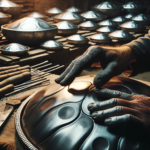<!DOCTYPE html>
<html lang="en">
<head>
<meta charset="UTF-8">
<meta name="viewport" content="width=device-width, initial-scale=1.0">
<title>Handpan Durability</title>
<style>
body {
font-family: Arial, sans-serif;
line-height: 1.6;
margin: 20px;
max-width: 800px;
}
h2 {
color: #333;
}
h3 {
color: #444;
}
p {
margin: 15px 0;
}
ul {
margin: 10px 0;
padding-left: 20px;
}
li {
margin-bottom: 5px;
}
</style>
</head>
<body>
<h2>The Hidden Strengths: Factors that Contribute to Handpan Durability</h2>
<p>
In the world of musical instruments, the handpan holds a unique place with its ethereal resonance and visually captivating design. Despite its relative novelty, having been developed only in the early 21st century, the handpan has managed to capture the imagination of musicians and listeners alike. While much is said about the sound and aesthetic qualities of handpans, their durability is a less frequently discussed aspect amidst enthusiasts and potential buyers. Understanding the factors that contribute to the durability of this exquisite instrument not only helps in making informed purchasing decisions but also aids in proper maintenance.
</p>
<h3>Material Composition</h3>
<p>
The choice of materials is crucial in determining the durability of a handpan. Traditionally, handpans are constructed using nitrided steel, a process that involves hardening the steel to make it more resistant to wear and corrosion. This material is particularly suitable for handpans due to its ability to withstand environmental stressors such as humidity and temperature changes, which are common detractors of other metal instruments.
</p>
<p>
An alternative material that some manufacturers now utilize is stainless steel. Handpans made from stainless steel are known for their exceptional resistance to rust and corrosion, making them particularly advantageous in regions with high humidity or for musicians who frequently travel. However, the tonal characteristics of stainless steel can differ from nitrided steel, often producing longer sustain and a slightly different timbre, impacting the overall sound quality.
</p>
<h3>Manufacturing Techniques</h3>
<p>
The craftsmanship involved in handpan manufacturing is a fine balance between art and science. Skilled artisans use various techniques to shape and tune the instrument precisely. The hammering process applied during fabrication, which involves careful adjustments and multiple stages of tuning, directly impacts the structural integrity and durability of the instrument. This meticulous approach ensures that the handpan maintains its desired sound characteristics over time, even with regular use.
</p>
<p>
Additionally, some handpan makers employ a heat treatment process, reinforcing the material and enhancing the toughness of the instrument. This procedure not only contributes to the longevity of the handpan but can also improve its sonic performance, as it allows the instrument to retain its tuning over extended periods.
</p>
<h3>Design Considerations</h3>
<p>
The design of a handpan also plays a significant role in its durability. Features such as the thickness of the metal, the curvature of the playing and resonant surfaces, and the overall architecture of the instrument determine how well the handpan can resist physical impacts and environmental stress. A well-designed handpan not only produces harmonious sounds but is also structurally sound, capable of enduring years of playing without significant deterioration.
</p>
<p>
Furthermore, the placement of notes and the spacing between them are critical. If the notes are too close, it may weaken the structural integrity and affect the durability over time. Thus, it's important for artisans to balance the acoustic requirements with the physical strengths when designing a handpan.
</p>
<h3>Regular Maintenance</h3>
<p>
Like any musical instrument, a handpan requires regular maintenance to ensure its longevity. Proper care includes cleaning the surface to remove oils and dirt, which can reduce the risk of corrosion. Most handpan players recommend using microfiber cloths to gently clean the instrument after each use. Moreover, applying a light coat of oil occasionally can create a protective barrier against moisture.
</p>
<p>
Ensuring the handpan is stored in a dry, temperature-stable environment significantly enhances its life. Exposure to extreme temperatures or humidity can cause the steel to warp or rust. Additionally, using protective cases during transport not only prevents physical damage but also minimizes exposure to harsh environmental conditions.
</p>
<h3>Conclusion</h3>
<p>
The hidden strengths that contribute to handpan durability are intertwined across various aspects, including material choice, manufacturing techniques, design considerations, and regular maintenance. Each of these factors plays a pivotal role in ensuring that a handpan remains a resilient and enduring musical companion. Whether you are a seasoned musician or a new enthusiast, understanding these elements can help you appreciate the craftsmanship behind this enchanting instrument and ensure its longevity for years to come.
</p>
<h3>Frequently Asked Questions (FAQs)</h3>
<ul>
<li><strong>What materials are typically used to make a handpan?</strong></li>
<p>Handpans are primarily made from nitrided steel or stainless steel. Nitrided steel offers corrosion resistance and durability, while stainless steel is known for its superior rust resistance.</p>
<li><strong>How should I clean and maintain my handpan?</strong></li>
<p>You should clean your handpan with a soft microfiber cloth to remove oils and dirt. Applying a light coat of oil can help protect against moisture, and it’s essential to store the handpan in a dry, stable environment.</p>
<li><strong>Does the thickness of the metal impact the durability of a handpan?</strong></li>
<p>Yes, the thickness of the metal affects both the sound quality and durability. Thicker metals can provide more strength to withstand impact, while also affecting the tonal characteristics.</p>
<li><strong>How can I protect my handpan during transport?</strong></li>
<p>To protect your handpan during transport, use a padded case. This prevents scratches and minimizes exposure to changes in weather conditions which can affect the metal.</p>
<li><strong>Can environmental conditions affect my handpan?</strong></li>
<p>Yes, environmental conditions such as humidity and temperature extremes can affect the tuning and structural integrity of a handpan. Storing the instrument in a controlled environment is recommended.</p>
</ul>
</body>
</html>The Hidden Strengths: Factors that Contribute to Handpan Durability

Leave a comment




